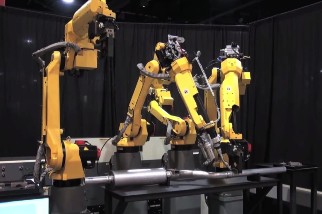 The design of equipment and tasks plays a major role in the level of risk that workers face. Considering the impacts on safety and health during the design phase can help mitigate or eliminate some of those risks before they have the potential to cause injuries and illnesses.
The design of equipment and tasks plays a major role in the level of risk that workers face. Considering the impacts on safety and health during the design phase can help mitigate or eliminate some of those risks before they have the potential to cause injuries and illnesses.
Georgi Popov, Ph.D., CSP, SMS, QEP, ARM, CMC, FASSP, FAIHA, chair of the occupational risk and safety sciences department at the University of Central Missouri, assisted an exhaust pipe manufacturer in developing a better design for welding stations to reduce worker exposure to hazardous chemicals, improve ergonomics and strengthen its bottom line.
The Problem
An exhaust pipe manufacturer wanted to improve the design of welding stations at its facility. The current design exposed welders to hexavalent chromium, raised ergonomic concerns and resulted in financial losses for the manufacturer.
Samples of the work environment showed that most welders faced overexposure to hexavalent chromium based on the requirements of OSHA’S hexavalent chromium standard. Hexavalent chromium exposure can lead to health conditions ranging from asthma and bronchitis to nasal septum ulcers and lung cancer.
A new welding station design would need to reduce worker exposure to hexavalent chromium to comply with the standard. The manufacturer also wanted to reduce the financial and strategic risk associated with the welding stations.
The Solution
No design safety review of the welding stations had previously occurred, and the manufacturer’s safety and health department convinced the management team it was an important step. The design safety review examined previous losses, exposures and concerns about efficiency, productivity, and overall safety and health.
Using ANSI/ASSP Z590.3 as a guide, the safety design review led to the establishment of minimum safety requirements for a new welding station design. There would be no freely distributed welding emissions in open areas, no task requiring a respirator or air-supplied welding helmet, no energized work and no exposure to noise levels above 80 dBA for an eight-hour total weigh average.
The Outcome
The manufacturer installed robotic equipment to conduct the handling and welding of the exhaust pipes. This removed the workers from the welding process and thus eliminated the risk of hexavalent chromium exposure and lifting heavy exhaust pipes. In addition, the manufacturer moved ventilation to the floor level so that filters could be easily and efficiently replaced without having to stop the entire operation. The installation of an automated system demonstrated that risk reduction can improve operational efficiency and that using prevention through design techniques can have favorable financial outcomes for your organization.
Understanding Risk Management and Assessment
Get the resources and expert guidance you need to improve how you assess risks to prevent hazards, protect workers and safeguard equipment.
Learn more